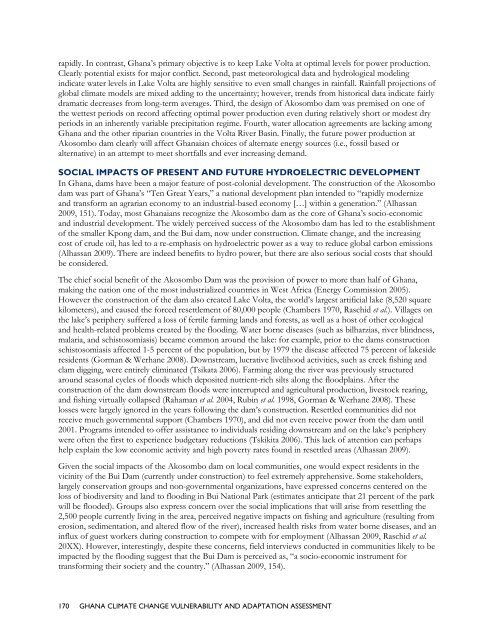ghana climate change vulnerability and adaptation assessment
ghana climate change vulnerability and adaptation assessment
ghana climate change vulnerability and adaptation assessment
- No tags were found...
Create successful ePaper yourself
Turn your PDF publications into a flip-book with our unique Google optimized e-Paper software.
apidly. In contrast, Ghana’s primary objective is to keep Lake Volta at optimal levels for power production.Clearly potential exists for major conflict. Second, past meteorological data <strong>and</strong> hydrological modelingindicate water levels in Lake Volta are highly sensitive to even small <strong>change</strong>s in rainfall. Rainfall projections ofglobal <strong>climate</strong> models are mixed adding to the uncertainty; however, trends from historical data indicate fairlydramatic decreases from long-term averages. Third, the design of Akosombo dam was premised on one ofthe wettest periods on record affecting optimal power production even during relatively short or modest dryperiods in an inherently variable precipitation regime. Fourth, water allocation agreements are lacking amongGhana <strong>and</strong> the other riparian countries in the Volta River Basin. Finally, the future power production atAkosombo dam clearly will affect Ghanaian choices of alternate energy sources (i.e., fossil based oralternative) in an attempt to meet shortfalls <strong>and</strong> ever increasing dem<strong>and</strong>.SOCIAL IMPACTS OF PRESENT AND FUTURE HYDROELECTRIC DEVELOPMENTIn Ghana, dams have been a major feature of post-colonial development. The construction of the Akosombodam was part of Ghana’s “Ten Great Years,” a national development plan intended to “rapidly modernize<strong>and</strong> transform an agrarian economy to an industrial-based economy […] within a generation.” (Alhassan2009, 151). Today, most Ghanaians recognize the Akosombo dam as the core of Ghana’s socio-economic<strong>and</strong> industrial development. The widely perceived success of the Akosombo dam has led to the establishmentof the smaller Kpong dam, <strong>and</strong> the Bui dam, now under construction. Climate <strong>change</strong>, <strong>and</strong> the increasingcost of crude oil, has led to a re-emphasis on hydroelectric power as a way to reduce global carbon emissions(Alhassan 2009). There are indeed benefits to hydro power, but there are also serious social costs that shouldbe considered.The chief social benefit of the Akosombo Dam was the provision of power to more than half of Ghana,making the nation one of the most industrialized countries in West Africa (Energy Commission 2005).However the construction of the dam also created Lake Volta, the world’s largest artificial lake (8,520 squarekilometers), <strong>and</strong> caused the forced resettlement of 80,000 people (Chambers 1970, Raschid et al.). Villages onthe lake’s periphery suffered a loss of fertile farming l<strong>and</strong>s <strong>and</strong> forests, as well as a host of other ecological<strong>and</strong> health-related problems created by the flooding. Water borne diseases (such as bilharzias, river blindness,malaria, <strong>and</strong> schistosomiasis) became common around the lake: for example, prior to the dams constructionschistosomiasis affected 1-5 percent of the population, but by 1979 the disease affected 75 percent of lakesideresidents (Gorman & Werhane 2008). Downstream, lucrative livelihood activities, such as creek fishing <strong>and</strong>clam digging, were entirely eliminated (Tsikata 2006). Farming along the river was previously structuredaround seasonal cycles of floods which deposited nutrient-rich silts along the floodplains. After theconstruction of the dam downstream floods were interrupted <strong>and</strong> agricultural production, livestock rearing,<strong>and</strong> fishing virtually collapsed (Rahaman et al. 2004, Rubin et al. 1998, Gorman & Werhane 2008). Theselosses were largely ignored in the years following the dam’s construction. Resettled communities did notreceive much governmental support (Chambers 1970), <strong>and</strong> did not even receive power from the dam until2001. Programs intended to offer assistance to individuals residing downstream <strong>and</strong> on the lake’s peripherywere often the first to experience budgetary reductions (Tskikita 2006). This lack of attention can perhapshelp explain the low economic activity <strong>and</strong> high poverty rates found in resettled areas (Alhassan 2009).Given the social impacts of the Akosombo dam on local communities, one would expect residents in thevicinity of the Bui Dam (currently under construction) to feel extremely apprehensive. Some stakeholders,largely conservation groups <strong>and</strong> non-governmental organizations, have expressed concerns centered on theloss of biodiversity <strong>and</strong> l<strong>and</strong> to flooding in Bui National Park (estimates anticipate that 21 percent of the parkwill be flooded). Groups also express concern over the social implications that will arise from resettling the2,500 people currently living in the area, perceived negative impacts on fishing <strong>and</strong> agriculture (resulting fromerosion, sedimentation, <strong>and</strong> altered flow of the river), increased health risks from water borne diseases, <strong>and</strong> aninflux of guest workers during construction to compete with for employment (Alhassan 2009, Raschid et al.20XX). However, interestingly, despite these concerns, field interviews conducted in communities likely to beimpacted by the flooding suggest that the Bui Dam is perceived as, “a socio-economic instrument fortransforming their society <strong>and</strong> the country.” (Alhassan 2009, 154).170 GHANA CLIMATE CHANGE VULNERABILITY AND ADAPTATION ASSESSMENT
















